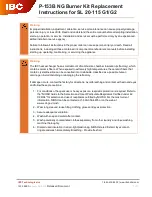
-
If the glass Circuit Breaker is lit, measure the resistance between the phase and neutral
terminals of the pump, motorised valve, terminals A1 and A2 of the contactor coil, A1 and A2
terminals of the relays on the board to detect the part that may caused the short-circuit and replace
it. If a part that may caused the short-circuit is not detected after the checks, replace the mainboard
and turn the device back on.
4-If the glass Circuit Breaker of the mainboard is intact, measure the resistance between the
contactor output contacts (contacts no. 2, 4 and 6) while the voltage supply of the device is off and
observe if there is a short-circuit. If there is a short-circuit, disconnect the connections to find the
condition in which the short-circuit is eliminated, and replace the cable or contactor that caused the
short-circuit.
5- If there is no short-circuit, measure the resistance between the phase input terminals of all the
resistors and the neutral busbar, and check if there is a short-circuit. If one of the terminal of the
resistors is short-circuited, replace the resistor.
6- If a short-circuit condition is not detected after checking the resistors, restart the device and run it
at full load for 10 minutes. If the Circuit Breaker does not blow during this time, turn the device on.
The reason for blowing the Circuit Breaker may be that the environment where the boiler is located is
too hot or phase fluctuations in the grid voltage.
7- If this happens more than once, the Circuit Breaker may be faulty and its replacement may be
required.
3. ASSEMBLYING/DISASSEMBLYING PROCEDURES OF PARTS
3.1. Front Panel
In order to remove the front panel, firstly the connecting screws at the bottom must be unscrewed
and then the panel should be removed by lifting it from below.
Suitable Hand Tool: Cross-screwdriver
3.2. Side Panels
They should be opened to the side by unscrewing the connection screws at the top and bottom,
and then removed.
Suitable Hand Tool: Cross-screwdriver
3.3. Contactor
To remove the contactor on the rail, hold the contactor and push it slightly upwards so that the
spring mechanism behind it is released from the rail and remove the contactor.
A cross-screwdriver should be used to remove the cable connections.
Suitable Hand Tool: Cross-screwdriver
Suitable Tightening Torque: Main Contact Connections: 2.25±0.25 Nm
Auxiliary Contact and Coil
Connections: 1±0.2 Nm
21
















































